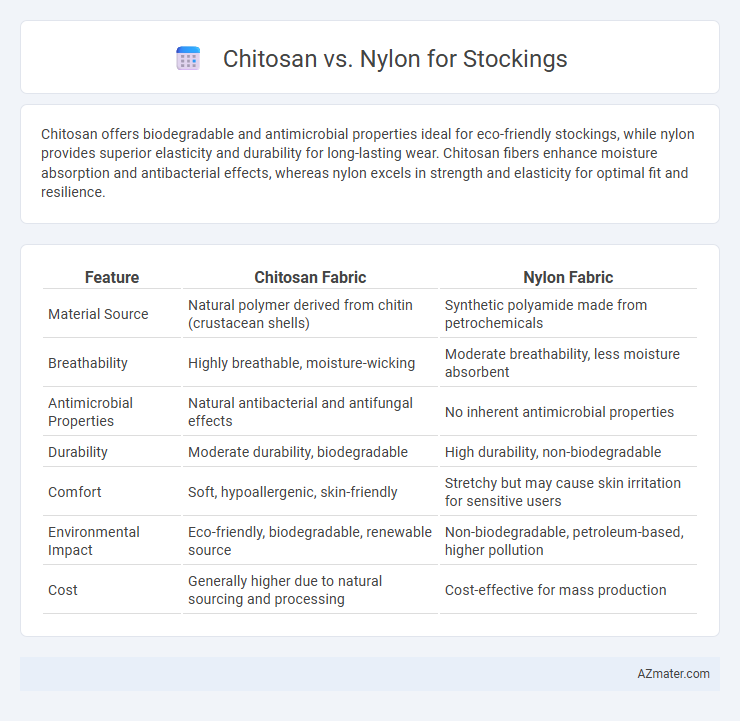Chitosan offers biodegradable and antimicrobial properties ideal for eco-friendly stockings, while nylon provides superior elasticity and durability for long-lasting wear. Chitosan fibers enhance moisture absorption and antibacterial effects, whereas nylon excels in strength and elasticity for optimal fit and resilience.
Table of Comparison
| Feature | Chitosan Fabric | Nylon Fabric |
|---|---|---|
| Material Source | Natural polymer derived from chitin (crustacean shells) | Synthetic polyamide made from petrochemicals |
| Breathability | Highly breathable, moisture-wicking | Moderate breathability, less moisture absorbent |
| Antimicrobial Properties | Natural antibacterial and antifungal effects | No inherent antimicrobial properties |
| Durability | Moderate durability, biodegradable | High durability, non-biodegradable |
| Comfort | Soft, hypoallergenic, skin-friendly | Stretchy but may cause skin irritation for sensitive users |
| Environmental Impact | Eco-friendly, biodegradable, renewable source | Non-biodegradable, petroleum-based, higher pollution |
| Cost | Generally higher due to natural sourcing and processing | Cost-effective for mass production |
Introduction to Stocking Materials
Stocking materials such as chitosan and nylon differ significantly in composition and performance, with chitosan derived from natural sources like crustacean shells, offering biodegradability and antimicrobial properties. Nylon, a synthetic polymer, provides high durability, elasticity, and resistance to abrasion, making it a popular choice for everyday wear. Understanding these material characteristics is essential for selecting stockings that balance comfort, sustainability, and longevity.
Overview of Chitosan: Properties & Benefits
Chitosan, a natural biopolymer derived from chitin in crustacean shells, offers exceptional biodegradability, antimicrobial properties, and excellent moisture absorption for stocking applications. Its biocompatibility ensures gentle, hypoallergenic use on skin, promoting comfort and reducing irritation compared to synthetic fibers like nylon. Enhanced breathability and eco-friendly characteristics make chitosan an innovative alternative, balancing durability with environmental sustainability in hosiery materials.
Understanding Nylon: Features & Applications
Nylon, a synthetic polymer known for its exceptional strength, elasticity, and abrasion resistance, is widely used in stocking manufacturing due to its lightweight and durable properties. Its moisture-wicking abilities and quick-drying nature make nylon stockings comfortable for extended wear, while its ability to retain shape enhances fit and appearance. Nylon's versatility extends to various applications including apparel, industrial fabrics, and hosiery, where its resilience and smooth texture are highly valued.
Sustainability: Chitosan vs Nylon
Chitosan stocks offer superior sustainability compared to nylon due to their biodegradability and renewable origin from crustacean shells, reducing environmental impact. Nylon, derived from petrochemicals, contributes to microplastic pollution and relies on non-renewable fossil fuels, leading to higher carbon emissions. Incorporating chitosan in stockings supports eco-friendly production, waste reduction, and enhanced biodegradation after disposal.
Comfort and Skin Compatibility
Chitosan stockings offer superior comfort and skin compatibility due to their natural, biodegradable fibers that promote breathability and moisture absorption, reducing irritation and allergic reactions often caused by synthetic materials. In contrast, nylon stockings, while durable and elastic, can trap heat and moisture against the skin, increasing the risk of discomfort and skin sensitivity. Chitosan's antibacterial and hypoallergenic properties enhance skin health, making it a preferable choice for individuals with sensitive skin or those seeking eco-friendly options.
Durability and Strength Comparison
Chitosan fibers exhibit superior biodegradability and antimicrobial properties but generally lack the tensile strength and durability of nylon when used in stockings. Nylon offers high resistance to wear, stretching, and tearing, making it a preferred choice for long-lasting, durable hosiery. The durability of nylon stockings is enhanced by its synthetic polymer structure, while chitosan-based stockings may require blending with other fibers to achieve comparable strength.
Moisture Management & Breathability
Chitosan fibers exhibit superior moisture management compared to nylon by effectively absorbing and wicking sweat while maintaining antimicrobial properties that reduce odor. Nylon stocks excel in breathability due to their lightweight and quick-drying capabilities but lack the natural moisture absorption found in chitosan. Combining chitosan's bioactivity with nylon's durability results in stockings optimized for comfort and odor control during prolonged wear.
Cost Analysis: Chitosan vs Nylon Stockings
Chitosan stockings typically have higher production costs compared to nylon due to the expensive raw materials and complex manufacturing processes involved in extracting and processing chitosan from crustacean shells. Nylon stockings benefit from mass production economies, resulting in lower unit costs and wider affordability. When evaluating cost-effectiveness, nylon is generally favored for budget-conscious consumers, while chitosan offers added antimicrobial and biodegradability benefits that may justify the premium price in specialized applications.
Environmental Impact and Biodegradability
Chitosan stockings offer significant environmental advantages over nylon due to their biodegradability and origin from natural sources like crustacean shells, reducing plastic waste accumulation. Nylon stockings, derived from petrochemicals, contribute to long-lasting microplastic pollution and have a larger carbon footprint throughout production and disposal. Chitosan's ability to decompose naturally within months contrasts sharply with nylon's persistence in ecosystems, making chitosan a more sustainable material choice for eco-friendly hosiery.
Future Trends in Stocking Material Innovations
Chitosan-based stockings are gaining traction due to their eco-friendly, biodegradable properties and natural antimicrobial effects, aligning with growing consumer demand for sustainable fashion. Innovations in nanotechnology are enhancing chitosan fiber strength and elasticity, positioning it as a competitive alternative to traditional nylon materials. Future trends indicate a shift towards hybrid fibers combining chitosan with synthetic polymers to optimize durability, comfort, and environmental impact in stocking production.

Infographic: Chitosan vs Nylon for Stocking
 azmater.com
azmater.com